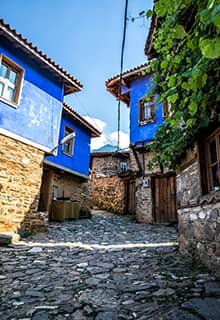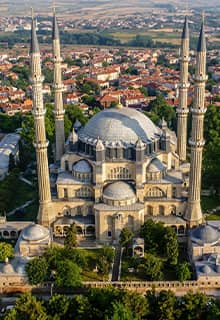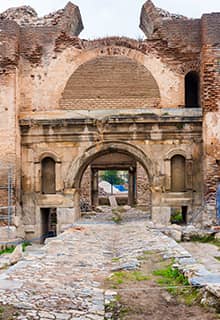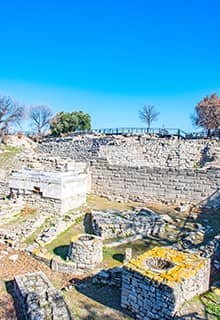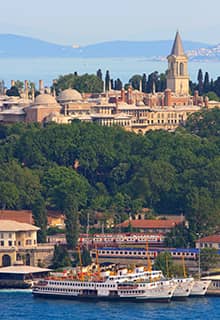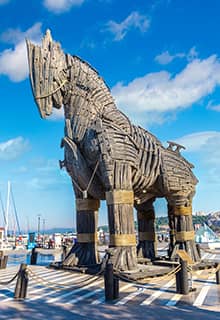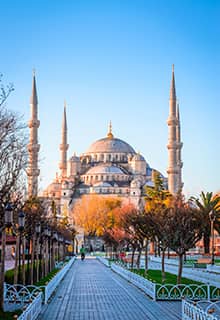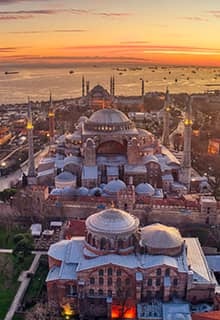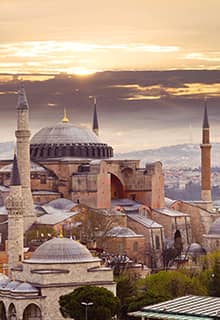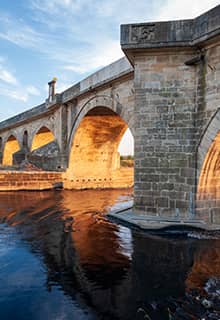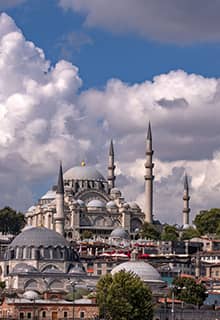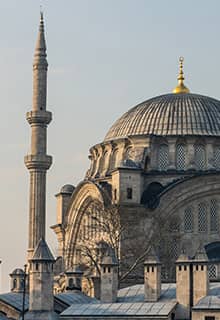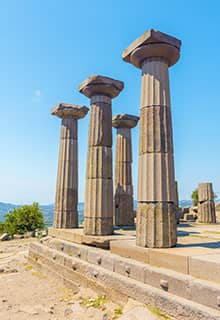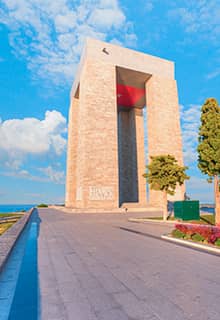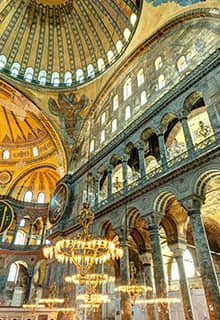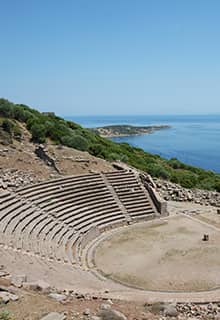

Marmara Türkiye
UNESCO Heritage Sites and Routes
Archaeological Site of Troy, Çanakkale
UNESCO World Heritage Site 1998
Troy, or Troia as it is mentioned in Homer’s epic Iliad, is located at the entrance of the Dardanelles, 30 km west of Çanakkale. The strait is the backdrop of the legend of Hero and Leander, the celebrated lovers of Greek mythology. It also holds a significant place in history. In 480 BC, the Persian army of Xerxes I crossed the strait on a pontoon bridge, and Alexander the Great did the same in 334 BC on his expedition against Persia. The strait has always been of great strategic and economic importance as the gateway to İstanbul and the Black Sea from the Mediterranean. “The Winds Brought Wealth to Troia”. Indeed, the strong northern winds of this area, made it a challenge to cross the Dardanelles, and the lower countercurrent under the Dardanelles made it even worse. Sailors discovered that placing a deep net under the boat allowed them to catch this countercurrent and cross the strait. In any case, boats had to wait in the harbors of Troy, and as it was right on the crossroads, trade made the city extremely wealthy. Prosperity gave rise to cultural wealth, and excavations have confirmed a wealth comparable to that described in the Iliad.
Excavations have identified a sequence of nine principal strata representing nine periods. Another layer was discovered in 2019, dating Troy back to 3600 BC. Troy VIIa, which was destroyed by fire sometime about the 13th century BC, is probably the city of King Priam described in Homer’s Iliad. Homer immortalized Troy in the stories of King Priam, Hector, Paris, and the beautiful Helen. A symbolic wooden Trojan horse commemorates the legendary war. Recent excavations have left no doubt that Troy was an Anatolian city. The discovery of a Chalcolithic mound on the Dardanelles closed the historical gap, and the Luwian seal discovered has proved the city’s Luwian connection. The Hittite texts talk about a treaty between the Hittites and Prince Alakşandu of Wiluşa who is identified as Alexander of Ilios, better known as Paris of Troy, in the Iliad. The Greek Troy was called “Wilusa/Taurisa” during the Bronze Age. Troy also officially claimed ancestry from the Roman Empire through Aeneas. Today, the city walls of Troy VI stand as a reminder of the great Homeric city that resisted the Greeks. The Temple of Athena, the central megaron complex of Troy II, the Palace of Priam from Troy VI, the Sanctuary of Demeter, the Odeon and the nearby Bouleuterion from the Roman period are still in relatively good condition. The new museum at Troy houses precious items from the site and many of the treasures of Troy. The treasures which were taken away by Heinrich Schliemann will hopefully one day return to their rightful home. On September 30, 1996, the Turkish government declared the site of Troy and its immediate surroundings a “National Historical Park” and the site was added to the UNESCO World Heritage List in 1998.
Çanakkale (Dardanelles) and Gelibolu (Gallipoli) Battles Zones in the First World War, Çanakkale
UNESCO World Heritage Tentative List 2014
Çanakkale and Gelibolu are famous across the world due to the battle that took place here at the beginning of World War I. In Türkiye, the battle is known as the “Battle of Çanakkale” and in the West it is known as the “Gallipoli Campaign.” The Gallipoli Campaign took place on the Gallipoli Peninsula, between February 17, 1915 and January 9, 1916. The Entente Powers or the Allies of World War I, Britain, France, and Russia, sought to weaken the Ottoman Empire by taking control of the Turkish Straits. This would expose the Ottoman capital Constantinople (modern-day İstanbul) to bombardment by the Allies’ battleships and would cut it off from the Asian part of the empire. With the Ottoman Empire defeated, the Suez Canal would be safe, and a year-round supply route could be opened through the Black Sea to ports in Russia. The Allied fleet's attempt to force the Dardanelles in February 1915 failed and was followed by an amphibious landing on the Gallipoli Peninsula in April 1915. In January 1916, after eight months' fighting, with approximately 250,000 casualties on each side, the land campaign was abandoned, and the invasion force withdrawn. It was a horrible defeat for the sponsors, especially Winston Churchill, while the campaign was considered a great Ottoman victory. In Türkiye, it is regarded as a defining moment in the history of the state, a final surge in the defense of the motherland as the Ottoman Empire retreated. The struggle formed the basis for the Turkish War of Independence and the declaration of the Republic of Türkiye eight years later, with Mustafa Kemal Atatürk, who rose to prominence as a commander at Gallipoli, as founder and president. The battlefields are now a national park; together with the war graves, numerous monuments, and war-related artifacts, they are registered as “historical sites and objects.”
Archaeological Site of Assos, Çanakkale
UNESCO World Heritage Tentative List 2017
Assos is perhaps one of the most scenic and magnificent ancient cities in Türkiye. The ancient city is situated on a rocky hill, on the territory of modern Turkish village of Behramkale, 17 kilometers south of the district of Ayvacık in the province of Çanakkale. The site offers a beautiful view of the island of Lesbos. Archaeological evidence shows that the area was inhabited as early as the Bronze Age. The 4th century BC was a period of great prosperity for Assos when Hermias of Atarneus, a student and later father-in-law of Plato, ruled the city, as well as the rest of the Troad (today’s Biga Peninsula) and Lesbos. In 348 BC, Aristotle came to Assos and established a philosophical school where he taught for three years. The city can be visited in two parts: the acropolis and the lower city. The acropolis hosts the earliest Doric temple in Anatolia, a Temple of Athena, fortification walls, and a Turkish mosque from the early period. You can follow the path down to the lower city and visit the agora, the bouleuterion, the gymnasium, and enjoy the great view of Lesbos from the theater.
Bursa and Cumalıkızık: The Birth of the Ottoman Empire, Bursa
UNESCO World Heritage Site 2014
The Ottoman Empire was one of the world’s most important empires and perhaps one of the longest-surviving ones with a 600-year rule. The Hittite, Roman, and Ottoman Empires shared many common features such as common laws, respect to all religious beliefs, the state protection of commerce, and the guarantee of safety and justice. Turks came from Central Asia, and in AD 1071, they defeated the Byzantines on the eastern border and entered Anatolia. Several Turkic tribes settled across Anatolia and in 1299, one of these tribes led by Osman, planted the seeds of a world empire near Bursa, in Söğüt. The word “Osmanlı,” deriving from “Osman,” came to become known in the West as “Ottoman.”
Soon Osman and his son Orhan, enlarged the empire and moved its first capital city to Bursa. Bursa was the capital of the Ottoman Empire between 1335 and 1363. In the Ottoman language, the city was referred to as “Hüdavendigar” meaning "God's gift." There are several monuments from the early Ottoman period in Bursa such as Ulu Mosque (Grand Mosque of Bursa), Covered or Silk Bazaar, Green Mosque and the Tombs of Osman and Orhan. The castle area contains many houses reflecting late Ottoman architecture. Mount Uludağ (2543 m), the ancient Mysian Olympus, towers over Bursa, and has a well-known ski resort. Bursa also has thermal baths, old Ottoman mansions, palaces, and several museums.
Cumalıkızık is a popular village, 10 km from Bursa, that showcases the early Ottoman architectural style of civilian countryside homes. It was built as a vakıf (or waqf, charitable endowment under Islamic law) village at the foot of Mount Uludağ (2543 m) during the reign of Ottoman Sultan Orhan Gazi (1326-1360). Cumalıkazık holds 270 historical houses. Most of the houses in Cumalıkızık are three-story. They were built as adjoined which creates an atmosphere of brotherhood, collaboration, and good neighborhood relations. Family privacy was an important consideration when the houses were built. The materials used were wood, abode, and rubblestone, while the cobblestone streets are narrow and still feature the medieval gutter system. Bursa and Cumalıkızık together represent the creation of an urban and rural system that was established to bring prosperity and ensure development for the first capital city of the Ottoman Empire.
Historic Areas of İstanbul, İstanbul
UNESCO World Heritage Site 1985
İstanbul was the capital of two great world empires: the Eastern Roman (Byzantine) Empire and the Ottoman Empire. Serving as a capital city for almost 1,600 years, İstanbul is perhaps the richest open-air museum in the world. The city’s long and multicultural history is reflected in countless structures of immeasurable cultural value. This UNESCO World Heritage Site includes buildings and structures such as Sarayburnu (known in English as the “Seraglio Point”), Topkapı Palace, Ayasofya Mosque, Sultan Ahmet Mosque (known also as the “Blue Mosque”), Hagia Irene, Zeyrek Mosque, Süleymaniye Mosque, Little Hagia Sophia, and the Walls of Constantinople. The Historic Areas of İstanbul form a group of sites in the district of Fatih and were added to the UNESCO World Heritage List in 1985.
Selimiye Mosque and Its Social Complex, Edirne
UNESCO World Heritage Site 2011
The most famous architect of the Ottoman period is without a doubt Mimar Sinan (Architect Sinan), who lived in the 16th century, during the peak of the Ottoman Empire under Süleyman the Magnificent. Selimiye Mosque is located in Edirne, ancient Hadrianopolis, the former capital of the Ottoman Empire before İstanbul. Sinan considered Selimiye Mosque his “masterwork.” He constructed Selimiye Mosque (1568-1575) when he was 80 years old, under Sultan Selim II. The location of the mosque suggests Sinan was also a great city planner as the mosque can be seen from considerable distances. The mosque is the culmination of Sinan’s centralized-domed plans, the great central dome rising on eight massive piers in between which are impressive, recessed arcades. The Selimiye Mosque is considered the best example of mosques with eight piers. Elegant domes, reaching to the heavens, and towering, slim minarets characterize Ottoman mosque architecture; few mosques, however, are as visually stunning and architecturally significant as this one. The Selimiye Mosque Complex is sizable, measuring 190x130 meters, and is composed of the mosque, two square madrassas, an arasta (shopping mall) and a theological school. The dome stands on eight muqarnas domes that are supported by eight large piers. The muqarnas step outward and rise, creating a corbelled effect, and allowing for a more open space below, in order to create a vision directly towards the dome without being interrupted by piers.
İznik, Bursa
UNESCO World Heritage Tentative List 2014
Ancient İznik was called Nicaea (or Nicea) and was primarily known for hosting two Ecumenical Councils. İznik is located next to Lake İznik (the ancient Lake Ascanius), 75 km to Bursa and 150 km to İstanbul. Nicaea is closely associated with the First and Second Councils of Nicaea (which later came to be known as the First and Seventh Ecumenical Councils of the Christian Church), and the Nicene Creed, which comes from the First Council and is a statement of belief used in Christian liturgy. It was also the capital of the Empire of Nicaea following the Fourth Crusade in 1204, until the recapture of Constantinople by the Byzantines in 1261. The ancient city is surrounded on all sides by fortification walls. These are, in turn, surrounded by a double ditch on the land portions, which also included over 100 towers in various locations. Large gates on the three landbound sides of the walls provided the only entrance to the city. The ancient walls, with their towers and gates, are well-preserved. The ruins of mosques, baths, and houses, dispersed among the gardens and apartment buildings that now occupy a great part of the space within the Roman and Byzantine fortifications, show that the Ottoman period town center was once a place of importance. Outside the walls are the remnants of an ancient aqueduct. The Church of the Dormition, the principal Greek Orthodox church in Nicaea, was one of the most architecturally important Byzantine churches in Asia Minor. The Hagia Sophia of Nicea, where the Second Council of Nicea took place, was converted into a mosque when the Ottomans conquered the city in 1337? During the Ottoman period, İznik became well-known for its tile production. İznik ceramic tiles adorn İstanbul’s Sultan Ahmet Mosque which became known in the West as the “Blue Mosque.” Currently, excavations are under way in the Ottoman kilns where the historic İznik tiles were once made.
The Bridge of Uzunköprü, Edirne
UNESCO World Heritage Tentative List 2015
Edirne, ancient Hadrianopolis and the former capital of the Ottoman Empire before İstanbul, hosts numerous masterpieces including the famous Selimiye Mosque and several bridges. Uzunköprü Bridge, the world’s longest stone bridge, was built in the 15th century over the Ergene River by the order of Ottoman Sultan Murad II. It is 1,392 meters long and contains a total of 174 arches.
Yıldız Palace Complex, İstanbul
UNESCO World Heritage Tentative List 2015
The Yıldız Palace Complex, the residence of the sultan in the late 19th century, is situated on a hill overlooking the Bosphorus. The grounds at Yıldız Palace were acquired under Sultan Ahmed I in the beginning of the 17th century and were used for recreation by Sultan Murad IV and Sultan Selim III. They included a pavilion named after Sultan Selim III’s mother, Valide Sultan Mihrişah. Although many additions were made under different sultans, it was not until the reign of Abdülhamid II in the late 19th century, that a royal palace was created at Yıldız. Abdülhamid's predecessors were based at the Dolmabahçe Palace, and the Yıldız Palace was only used as the seat of the sultan between 1889 and 1909, after which Dolmabahçe again became the royal residence. The main components of the Yıldız Palace Complex are the Çadir Pavilion, the Malta Pavilion, the Şale Pavilion, the Opera House and Theatre, the Palace Museum, the Imperial Porcelain Factory, and government offices. A mosque, used by Sultan Abdülhamid on Friday during the Selamlik ceremony, also formed part of the complex. Today, the Yıldız Complex functions as a park and museum, and the Şale Pavilion is used for hosting private receptions.
Nuruosmaniye Complex, İstanbul
UNESCO World Heritage Tentative List 2016
Nuruosmaniye Mosque is an 18th-century mosque that is part of a complex in the historical Fatih district of İstanbul. The name derives from the “light of Osman,” after the Ottoman Sultan Osman III (1730-1754), but also because of the great numbers of windows allowing a lot of light inside the mosque. The mosque first started to be built under Sultan Mahmud I in the mid-18th century; however, it was completed under Sultan Osman in 1755. The complex, known is Turkish as a “külliye,” consists of the mosque, a madrassa, an imaret (public soup kitchen), a monumental tomb, a public fountain, and a library with an extraordinarily rich book and manuscript collection. The Nuruosmaniye Complex is considered the earliest example of Ottoman Baroque architecture due to the Baroque architectural elements such as exaggerated ornamentation, a large dome, the focus on light, the abundance of windows, the niched mihrab, and polygonal courtyard.
Sultan Bayezid II Complex: A Center of Medical Treatment, Edirne
UNESCO World Heritage Tentative List 2016
Edirne, the ancient Hadrianopolis and former capital of the Ottoman Empire before İstanbul, is home to numerous architectural masterpieces including the Complex of Sultan Bayezid II. The complex is the most famous example of a “külliye,” a complex of buildings in Ottoman architecture centered on a mosque. The construction of the complex began in 1484 and it was opened to the public in 1488. It was built under the patronage of Sultan Beyazid II. The complex contains, among others, a mosque, a hospital (darüşşifa), a medical school, two guesthouses, and a bridge. The hospital remained in service for four centuries and reflected a “holistic approach” to medicine and the treatment of mental disorders with aspects such as a central planning system, ventilation and lighting details, summer and winter patient rooms, and a music stage. The structure currently houses a museum dedicated to the history of medicine.
Design, İstanbul
UNESCO Creative Cities Network

